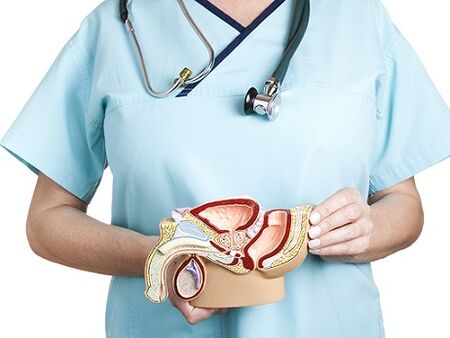Papillomas are bulging growths that appear on the human skin and mucous membranes. They are not actually a disease, but serve only the outward manifestation of infection of the body with HPV - human papillomavirus.
Papillomavirus exists in different strains, some of which are dangerous because neoplasms have the property of malignant transformation, i. e. they can turn into malignant tumors.
Causes of papillomas on the penis

Papillomas are benign growths on the skin or mucous membranes of the warty nature.
Human papillomavirus is transmitted in several ways, from a sick person to a healthy person. The main method is sexual intercourse with unprotected sexual intercourse. But you can "get" the virus through the household, through contact with a carrier, if there is a defect in the integrity of the body or mucous membranes, through the blood and other fluids infected with the virus.
It is quite difficult to completely "destroy" the virus that has already entered the body, but in about 90% of cases there is an independent cure, ie the immune system itself "kills" the virus. However, in some cases, the disease becomes recurrent and can last for many years.
Particularly dangerous are strains of malignant tumors, or malignant neoplasms.
HPV has a long incubation period, with strong immunity, can last from one month to one year.
But as soon as the immune system weakens, he immediately feels better. Symptoms of its presence are growths on the body and mucous membranes, which may have a round, oval or elongated shape and vary in size, from a few millimeters to several centimeters.
More than 600 strains of the virus are known in medicine, more than 40 of which can cause neoplasms in the genital and anal regions in men and women. They are the ones that cause papillomas on the penis, which are referred to as genital warts.
Some parts of the papilloma are harmless to human health, some can provoke an annoying cosmetic defect - warts, and some - the body with the most dangerous disease - cancer. There is medical evidence that cervical and breast cancer develop with infection with certain strains of HPV.
If a virus enters the body that can cause papillomas on the genitals, then sexual intercourse is considered to be the main route of its introduction. Especially dangerous are obscene relationships, bisexual and homosexual contacts. But the virus can be congenital - the fetus becomes infected as it passes through the birth canal of an infected mother. There is also a risk of infection of the skin lesions during swimming, public toilet, bath, sauna, gym, epilation, shaving.
Signs and symptoms of the disease

Symptoms depend on the site of localization, the number and size of papillomas.
Most often, papillomas on the penis damage the head of the body, "settle" along the atrium, form colonies on the larynx and may even penetrate the urethra.
With strong proliferation of papillomas take the form of "cauliflower", urination during sexual intercourse can be damaged, painful and even bleeding.
Since it is a viral disease, the period of activation of papilloma growth is accompanied by a strong weakening of immunity. A person feels weak, lethargic, his body temperature may rise, most often maintaining subfebrile levels (37 - 37, 5 ° C). Once immunity is impaired, an infected person can easily catch a cold and "take" ARVI and ARI.
Proliferation of papillomas can lead to phimosis - narrowing of the tibia.
Due to this condition, a special lubricant accumulates on the head of the penis - smegma. Its infection can lead to the development of a dangerous disease, so even if you find one of the papillomas, you urgently need to consult a doctor. Individual neoplasms can be removed very quickly and almost painlessly, preventing them from growing and a high risk of developing into a malignant tumor.
Required tests and examinations
The presence of papilloma is determined by the doctor visually, but other studies are needed to determine the strain and the degree of its risk to the patient. The patient donates blood for PCR, a Digen screening test, for typing, and is screened for sexually transmitted diseases, since in the vast majority of cases HPV is "packaged" with STDs.
If there is a suspicion of papilloma penetrating the urethra, urethroscopy is performed. Your doctor may order a biopsy if the growth is too large or if doctors suspect that the formation has begun to degenerate into a cancerous tumor.
Methods of treatment and removal of papillomas

It is impossible to completely remove human papillomavirus from an infected person, sometimes it stays in it for the rest of the patient's life. Medications to fight HPV are the use of antiviral drugs and immunomodulators that stimulate the activity of the human immune system.
Basically, the actions of doctors are aimed at eliminating the external signs of the presence of the virus, ie papillomas, warts and genital warts.
Only in the case of cancer degeneration is complex treatment used, which includes surgery and the use of chemotherapy to eliminate the risk of the tumor spreading.
The following methods of treatment are used to remove papillomas on the penis:
- Surgical removal.
- Electrocoagulation.
- Laser removal of formations (neodymium or carbon dioxide).
- Cryodestruction - destruction of a neoplasm using liquid nitrogen. Cryodestruction can be used or aerosolized.
- Cauterization with chemicals.
In most cases, the use of these methods is sufficient to remove the papilloma and prevent its recurrence.
The treatment method is chosen by the doctor according to the degree of the lesion, the type of neoplasm, the patient's state of health and his age.
There is a specialized vaccine that is used in women to prevent the most dangerous disease - squamous cell carcinoma, or cervical cancer. It has been proven to be caused by one of the most dangerous strains of human papillomavirus, as this type of cancer does not occur in the absence of HPV in the body.
Unfortunately, there is currently no vaccine that can prevent infection with other types of human papillomavirus, including those that provoke the appearance of growths on the male intimate organs. The only effective means of protection is still the use of condoms during sexual intercourse, as well as personal hygiene, careful treatment of possible infection in public places.
Prognosis and possible complications

Doctors have come to the conclusion that in 90% of all cases of HPV infection, if a person has a strong immunity, the body can independently deal with the virus within 24 months. But this observation applies only to certain strains of human papillomavirus that can not provoke the development of cancer.
The most dangerous complication should be considered a malignant tumor, or turning a papilloma into a cancer. But only a fraction of HPV strains have such properties. Unfortunate consequences can be avoided with early access to medical care and timely diagnosis.
In rare cases, after removal of the papilloma, tumors may form on and around the scar tissue if the virus is actively multiplying due to weakened immunity in the patient's body. In such a situation it is necessary to re-remove the papillomas and comprehensively strengthen the patient's immunity to prevent further growth of the formation.
In most cases, the prognosis is positive if the disease is not very advanced. But this rarely happens during genital warts because their development causes severe discomfort to the man and he quickly seeks medical attention.














































































